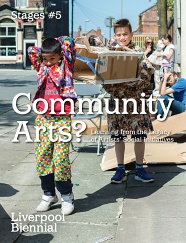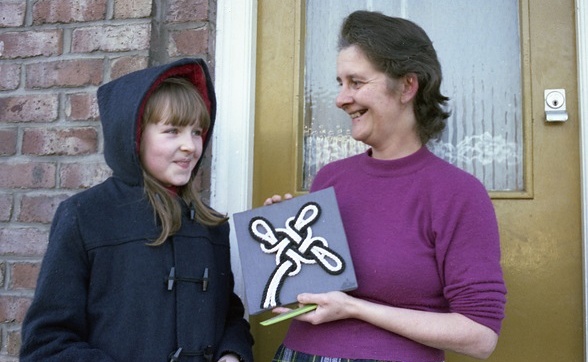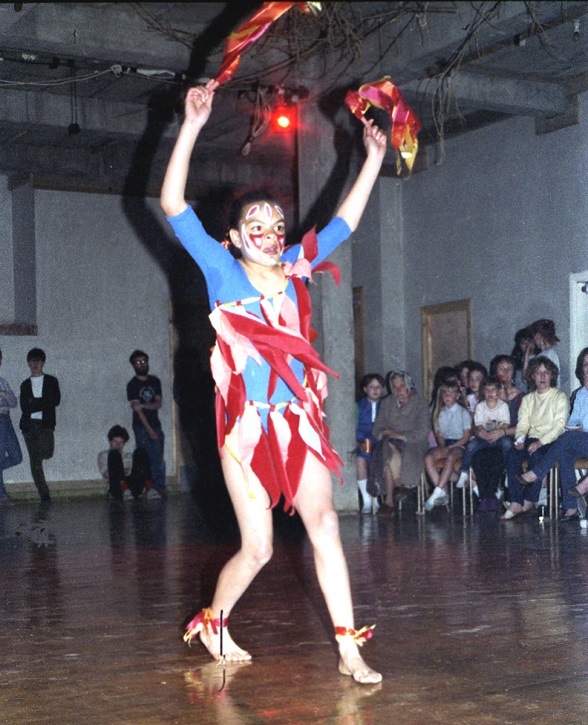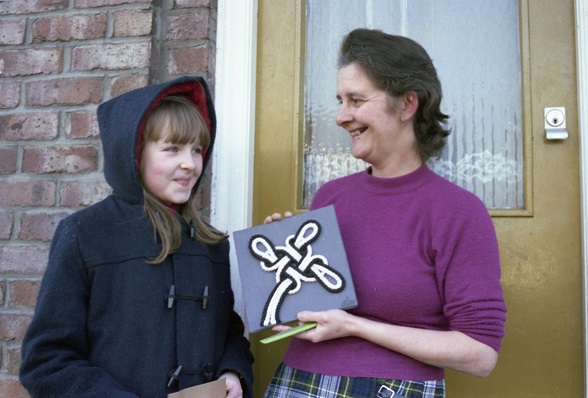
Take One: "Affection, Protection, Direction”
Wendy Harpe

Karen Bowden delivering knots to Knotty Ash as part of Thou Shalt Knot, Knotty Ash (Liverpool), 1982. Photo courtesy of Black-E Archive.
Karen Bowden delivering knots to Knotty Ash as part of Thou Shalt Knot, Knotty Ash (Liverpool), 1982. Photo courtesy of Black-E Archive.
Community Arts is not an art form but a form of practice, and by and large it can be applied to most situations. When Bill Harpe and I started the Black-E back in 1968, we had two principles in mind. One had to do with class. We both come from very working class backgrounds and we found ourselves working in the arts, for a middle class audience. I realised I was developing a project for a place that my mother would never ever set foot in. I thought we could absolutely do with being somewhere where this wasn’t the case.
 Meredith Monk performing Education of a Girl Child, Black-E, 1972. Photo courtesy of Black-E Archive.
Meredith Monk performing Education of a Girl Child, Black-E, 1972. Photo courtesy of Black-E Archive.
The second was the belief that it would not only just change the community to be exposed to the arts, but it would also change the arts to be based in a community. Our intention was to see what happened if we brought together artists and local communities. It was never our view that we would come with the arts and educate people roundabout as to what the arts were, neither did we say we would stop doing what interested us, just because the people roundabout didn’t like it. Instead, our view of Community Arts has been about encouraging creativity in both the people who are there as workers and the people who are there as users, in thus far as these two can be differentiated.
 The Last Poets performing at the Black-E’s 20th Birthday party, Black-E, 1988. Photo courtesy of Black-E Archive.
The Last Poets performing at the Black-E’s 20th Birthday party, Black-E, 1988. Photo courtesy of Black-E Archive.
However, this didn’t come without complications and the start of the Black-E was quite violent. Kids used the building a lot and once they were in they didn’t want to leave. They couldn’t see a reason why they shouldn’t dominate the building the whole time. One day, a kid came and said he wanted to come in, and I said he couldn’t because we were busy. He responded that I had to let him in because if I didn’t, he would have to go downtown instead, and he would rob and get arrested, so it would be my fault if he went to prison, because I hadn’t let him in.
Negotiating time for the things we had to do, our own work and public use was complex to begin with. There was also a huge difference between the people who came to the arts events, which we did from the beginning, and the kids who came to play football, swing on swings or do whatever we were putting out for them to do. It took two to three years before the two started to really come together. Bit by bit, we started providing the young people with things they would engage with. As Bill always said: ‘we gave them what they didn’t know they wanted.’ That’s what’s happened. Now we never get arguments about wasting time on art events.
 Young girl in performance of A Spring Tree, Black-E, 1984. Photo courtesy of Black-E Archive.
Young girl in performance of A Spring Tree, Black-E, 1984. Photo courtesy of Black-E Archive.
The arts community has proved less open than the local community, and every now and then we are told the Black-E could be a great art centre if the riff-raff was kept out. The art world hasn't found it easy to come to terms with an organisation that is a home for young people and which also promotes or creates contemporary art activities across art forms: so it tends to ignore us.
The Black-E is artist-led and has been since it started. Though at the time, I didn’t see myself as an artist, whereas Bill already identified as a dancer and choreographer. I was an administrator with a fine ability to pick good art. I promoted the first Mark Boyle event before it went to the Roundhouse in London, and we worked with John Latham before he was well known. We invited the composer Meredith Monk to come for two weeks in 1972. She performed her own work, worked with us and invented games for the kids. These are just some of many examples of artists we have collaborated with or promoted over the years.
 Man creating a portrait in The Rembrandt Game, Walker Art Gallery (Liverpool), 1978. Photo courtesy of Black-E Archive.
Man creating a portrait in The Rembrandt Game, Walker Art Gallery (Liverpool), 1978. Photo courtesy of Black-E Archive.
Today we are in a difficult situation; we have just received the largest funding cut to any regularly funded organisation on Merseyside – a cut which we might not survive. One of the reasons for this is that a lot of organisations are now doing projects around participation, so there is less need for us to do it. However we do this full-time, and other organisations do it occasionally when it interests them. When we first started, the only thing that existed in terms of outreach and community-based work was theatre and education. There have been important changes, now most art large institutions have an outreach or education alongside everything else they do.
I used to run the Bluecoat. We had something called the Bluecoat Arts Forum, which was a membership organisation. The music organisations were very prominent; there were about 200 in Merseyside at that time and they met regularly. The Philharmonic was a regular attendee and at one meeting they said they had engaged 5,000 young people in the last two months. Now organising school concerts, or providing free or cheap tickets to concerts isn’t what I call working with young people, it’s a way of building their future audience. Most education programmes run by arts organisations, as far as I can see, are actually about getting people to understand the arts within the institution and not about whether the people they engage with could become major artists themselves or whether they might have something to say that is more interesting than what the institution might have to say.
 Karen Bowden delivering knots to Knotty Ash as part of Thou Shalt Knot, Knotty Ash (Liverpool), 1982. Photo courtesy of Black-E Archive.
Karen Bowden delivering knots to Knotty Ash as part of Thou Shalt Knot, Knotty Ash (Liverpool), 1982. Photo courtesy of Black-E Archive.
Download this article as PDF
Wendy Harpe
Co-founder of the Black-E in Liverpool
Wendy started as an art administrator working as assistant to The director at the Cardiff Commonwealth Arts Festival 1965. Ran the Bluecoats Arts Forum which promoted contemporary work across the art forms including bring the 1st outdoor sculpture exhibition to Liverpool. Founded with Bill Harpe and Peter Moores The Blackie in 1968 and worked there full time until 1984 and on one off projects in the years that followed. I went on to Chair the Trustees and am still a Trustee. Am currently archiving the 40 plus years of the Black-E's work. In the interim worked at the GLC 1980s , The Arts Council Of Great Britain (1990s) and The BBC (1998-2006).
- Introduction: Community Arts? Learning from the Legacy of Artists' Social Iniatives
Andrea Phillips - Pass the Parcel: Art, Agency, Culture and Community
Nina Edge - What is at Stake in Community Practice? What Have We Learned?
Jason E. Bowman - Navigating Community Arts and Social Practice: a Conversation about Tensions and Strategies
Laura Raicovich and Prerana Reddy - Lay Theatre and the Eruption of the Audience
Alan Read - Drawing Lines across History: Reactivation and Annotation
Ed Webb-Ingall - Five Takes on Collaborative Practice and Working with Artists, Non-artists and Institutions: Introduction
Anna Colin - Take One: "Affection, Protection, Direction”
Wendy Harpe - Take Two: "Between Community Arts and Socially Engaged Practice"
Ania Bas - Take Three: "From Community Practice to Gallery Education"
Emily Pringle - Take Four: "Beyond the Mural"
Marijke Steedman - Take Five: "Participate in What is Already Going On"
Ana Laura López de la Torre - Colophon